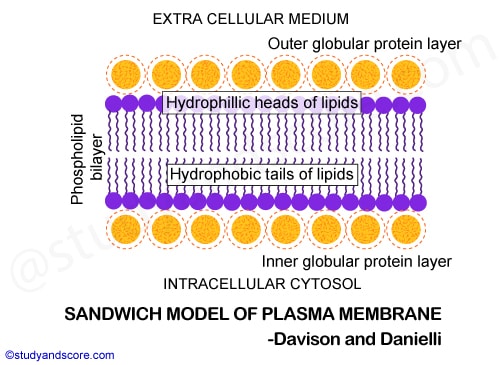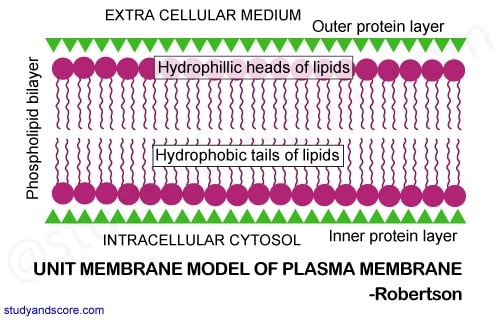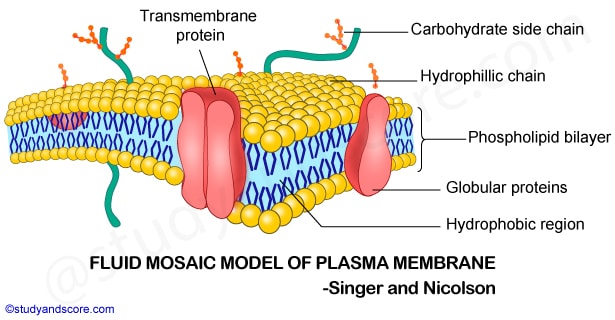The detailed structure of the plasma membrane could be studied only after the invention of the electron microscope. The study of the structure of plasma membrane is beyond the resolution of light microscope. Therefore, all the experiments conducted before the invention of electron microscope could only provide indirect evidence for the existence of a membrane like structure around the cell.
The existence of plasma membrane can be understood by the following points,
Various authors have given various models and concepts for the presence and structure of plasma membrane. But Fluid mosaic model proposed by Singer and Nicolson is the most accepted of them all. In 1902, Overton proposed a basic model for transport of small neutral solutes. He experimented on numerous cells both from plants and animals and concluded that these special osmotic properties of living protoplasts are due to selective solubility mechanism of the membrane. He also rightly guessed that outer layer of the membrane contained fats and sterols. Overton postulated that the plasma membrane is composed of a thin layer of lipid.
In 1926, Groter and Grendel conducted experiments on hemolyzed RBC and concluded that the RBCs were covered by two layers of lipid molecules over the entire cell surface. In 1931, Danielle and Harvey studied the surface tension of the cells. Generally surface tension at the water-oil interface is around 0.01-0.015 newton/meter on the other hand the surface tension for cells is nil. This low surface tension for the cell is attributed to the presence of proteins in the plasma membrane.
The following are the molecular models of the plasma membrane proposed by various biologists,
Sandwich model
In 1935, Davison and Danielli proposed sandwich or trilamellar model for plasma membrane structure. According to this model, plasma membrane is a sheath like structure composing of two lipid layers sandwiched between continuous layers of proteins. The stability of the membrane was maintained by the mutual attraction between hydrocarbon chains of lipids and electrostatic forces between proteins and lipid molecules.

They also predicted the thickness of the lipid layer to be about 6.0 nm and protein layer to be 1.0 nm. The total thickness was said to be around 8.0 nm. Finally electron micrograph studies also supported this model proposed by Davison and Danielli.
Unit membrane model
Later in 1959, Robertson proposed unit membrane hypothesis which states that all cellular membranes have an identical membrane structure. They named this identical membrane structure as unit membrane. According to this model, unit membrane consists of bimolecular lipid leaflet packed in between outer and inner layers of protein.

Fluid mosaic model
Finally in 1972, Singer and Nicolson proposed the well accepted Fluid mosaic model. As per this model, both lipids and proteins are distributed in a kind of mosaic arrangement. All the biological membranes are quasi-fluid structures in which lipids and the proteins are able to move. In other words, the proteins are embedded in lipid bilayer in such a way that proteins float in lipid sea. The surface of the lipid layers is interrupted by randomly distributed protein molecules. These proteins may either attach to the polar surface of the lipids or partially penetrate the lipid bilayer. Some proteins are also found to be associated with the sugar chains of glycoprotein.

| Prokaryotic plasma membrane | Eukaryotic plasma membrane |
|---|---|
| In prokaryotes and plants, the plasma membrane is an inner layer of protection in the presence of outer cell wall. | In eukaryotes, the plasma membrane is the outer layer of protection, as the outer cell wall is absent. |
| The cell wall has pores and is not very selective about the passage of molecules. Here, plasma membrane is responsible for selective permeability of the molecules. | In the absence of cell wall, plasma membrane is completely responsible for selective permeability of the molecules. |
| Prokaryotic plasma membrane is a phospholipid bilayer with embedded proteins. | Eukaryotic plasma membrane is a phospholipid bilayer with embedded proteins and carbohydrates. |
| Prokaryotic plasma membrane has no sterols. | Eukaryotic plasma membrane has sterols like cholesterol in its hydrophobic core. |
| Prokaryotes may have multiple plasma membranes. | Eukaryotes have only one plasma membrane. |
| In the absence of sterols, the plasma membrane of prokaryotes is less rigid and less stable. | The presence of the sterols gives more rigidity and stability to the membrane. |

- Share with your friends! -
Login to post your comment here...
- or with social Account -